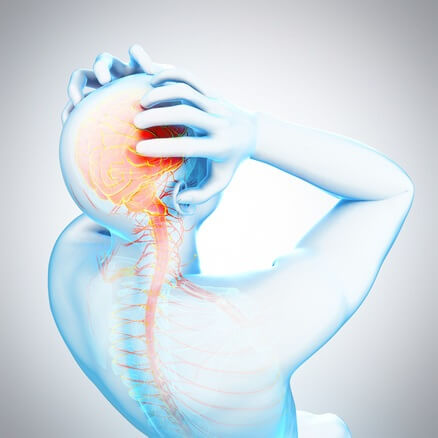A Pain in the Neck? Check out our fantastic new service.
HEADACHE AND MIGRAINE
 A pain in the neck?
A pain in the neck?
Over 3 million people in Australia suffer from headache or a migraine (that’s 12-15% of people) at an estimated cost of $1 billion to the economy.(1) It is also estimated that up to 65% of the population will suffer from chronic or recurrent headaches or migraines.(1) Unfortunately, the current models of headache and migraine management have been unable to provide consistent, repeatable management options leaving many sufferers heavily medicated and hundreds, even thousands of dollars out of pocket in search of relief.
The International Headache Society classifies headache and migraine into 14 groups, and then subcategorises these groups, resulting in over 300 possible differential diagnoses for headache and migraine.(4,6,7) Are there over 300 causes for a headache and migraine? Unlikely. In following this complex system, it is easy to see how so many patients undergo numerous trials of differing treatment options. There must be a simpler way….
Current research now demonstrates a cervicogenic (neck related) component in up to 80% of headache and migraine sufferers.(2, 3) Although it may not be the only source, for a physiotherapist, this is a treatable and manageable component.
The Science
Prior to the 21st Century, migraine and chronic headache were thought to be caused by dilation of blood vessels in the head/face (11). More recent research has indicated that both migraine and cervicogenic headache have a similar underlying cause – a sensitised brainstem resulting in the abnormal processing of sensory information (2-3,5,8-10,12). A fault or dysfunction at the very top of the neck has the potential to not only lead to this sensitisation, but also trigger it when already sensitised.
Studies have shown that up to 80% of headache/migraine pain can be reproduced with specific manual palpation of the neck (10,13). Furthermore, with sustained and repeated mobilisation of the neck segment at fault, resolution of head and face pain can be gained during treatment (10). New research os indicating that this reproduction and resolution of specific head/face pain effectively reduces sensitisation of the brainstem (13) and subsequently reduces or even eliminates headache and migraine symptoms.
If you suffer from headache or migraine, call us now to arrange a FREE over the phone consult with one of our experienced therapists. If we decide to schedule an appointment, our assessment and treatment protocol can quickly and effectively assess the upper cervical spine to determine if the neck is a source of your headache or migraine pain.
CALL NOW – 9369 4999
References
1. Migraine: Migraine Australia (2017) http://headacheaustralia.org.au/migraine
2. Goadsby PJ, Bartsch T. Anatomy and physiology of pain referral patterns in primary and cervicogenic headache disorders. Headache Currents 2005;10:42-48.
3. Gallagher R. Cervicogenic Headache; A special report. Expert Rev. Neurotherapeutics 2007;7(10):1279-83.
4. The International Classification of Headache Disorders, 3rd edition (beta version). Cephalalgia. Jul 2013;33(9):629-808.
5. Rothbart P.(1996). The cervicogenic headache: A pain in the neck. Canadian Journal of Diagnosis; 13: 64-71.
6. Sjaastad O, Fredricksen TA, Pfaffenrath V. Cervicogenic headache: Diagnostic criteria. Headache. 1998;38:442-445.
7. Cephalalgia. 2003 Oct;23(8):814-9.
8. Antonaci F, Sjaastad O. (2010) Cervicogenic headache: A real headache. Current Neurology and Neuroscience Reports; 11:149-155.
9. Fredriksen T.A., Antonaci F., Sjaastad O. (2015) The Journal of Headache and Pain, 16:6.
10. Watson DH, Drummond PD. Head pain referral during examination of the neck in migraine and tension-type headache. Headache 2102 52;8:1226-1235.
11. Goadsby, P.J. (2009). The Vascular Theory of Migraine; a great story wrecked by the facts. Brain, 132(1) pp 6-7.
12. Bartsch TGP. Anatomy and physiology of pain referral in primary and cervicogenic headache disorders. Headache Curr. 2005;2:42-48.
13. Watson D. H, Drummond P.D. (2014). Cervical Referral of Head Pain in Migraineurs: Effects on the Nociceptive Blink Reflex.
